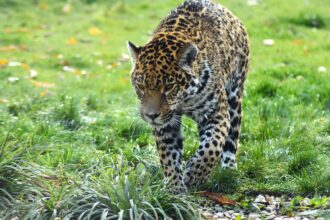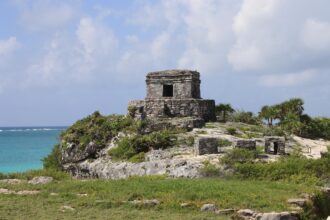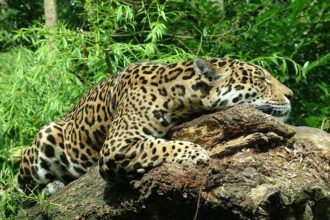The Importance of Jaguars in Mexico’s Ecosystem
Jaguars (Panthera onca) play a crucial role in maintaining the ecological balance of their habitats in Mexico. As apex predators, they regulate prey populations and help sustain the health of various ecosystems, including tropical and subtropical forests, wetlands, and grasslands. Recognizing their ecological importance has led to a surge in conservation efforts across the country, particularly in crucial regions such as the Yucatán Peninsula, Chiapas, and the Sierra Madre Oriental.
Jaguar Habitat and Distribution in Mexico
Mexico is home to approximately 30% of the entire jaguar population in Central and South America. These majestic big cats are found in diverse habitats, from dense tropical rainforests to arid scrubland. The most significant habitats include the Selva Maya—a vast expanse covering parts of Mexico, Belize, and Guatemala—and the Lacandon Jungle in Chiapas, known for its rich biodiversity.
Threats to Jaguars
Despite their ecological significance, jaguars face numerous threats, primarily due to human activities. Deforestation for agriculture, urban development, and illegal logging are pushing jaguars into smaller, fragmented habitats. Additionally, poaching and retaliatory killings by farmers, who view jaguars as threats to livestock, further reduce their numbers. Climate change also poses a significant threat, affecting food availability and habitat suitability.
Recent Developments in Jaguar Conservation
In recent years, Mexico has made significant strides in jaguar conservation by implementing a variety of initiatives and policies aimed at protecting these magnificent creatures and their habitats.
Establishment of Protected Areas
The Mexican government has designated multiple protected areas critical for jaguar conservation. For instance, the Federal Protected Area of the Selva Maya is a crucial refuge, providing a sanctuary for the jaguar population and numerous other species. In 2021, the government expanded the protected areas in Chiapas, leading to increased habitat security and conservation efforts.
Collaborative Conservation Efforts
Effective conservation requires collaboration among various stakeholders. In Mexico, NGOs, governmental bodies, and local communities are working hand in hand to protect jaguar populations. Organizations like the Jaguar Conservation Program and the WWF (World Wildlife Fund) have created partnerships with local communities, promoting sustainable practices and wildlife-friendly agricultural methods.
One successful collaborative effort is the “Jaguar Corridor” project, which aims to connect fragmented habitats through wildlife corridors. These corridors facilitate animal movement, reducing inbreeding and promoting diverse gene pools. Community involvement in this project has increased awareness and support for jaguar conservation.
Innovative Research and Technological Advances
Research plays a critical role in devising effective conservation strategies. Recent studies employing innovative technologies, such as camera traps and GPS collars, have provided valuable insights into jaguar behavior, population distribution, and habitat use. This data is essential for developing informed conservation strategies.
For example, ongoing studies in the Yucatán Peninsula utilize camera traps to monitor jaguar populations, revealing insights into their movements and prey selection. The data generated has been invaluable in refining protection strategies and informing land use planning.
Community Engagement and Eco-Tourism
Engaging local communities in conservation efforts is vital for achieving long-term success. Many residents inhabit regions where jaguars roam, making their involvement essential. Conservationists are now promoting eco-tourism initiatives that educate communities about the ecological role of jaguars while providing economic incentives to protect these magnificent cats.
In places like San Pancho in Nayarit, community members have developed eco-tourism ventures that offer guided tours highlighting the local flora and fauna, including the jaguar. This approach not only fosters pride in local biodiversity but also generates income that can be reinvested into conservation efforts.
Success Stories in Jaguar Conservation
-
The Yucatán Peninsula Corridor Project: This project has made substantial progress in re-establishing connections between fragmented habitats, leading to a resurgence of jaguar sightings in areas where they were previously absent.
-
Chiapas Initiatives: Conservation projects in Chiapas have achieved remarkable results, including increased jaguar populations due to habitat restoration and anti-poaching laws. Collaboration with local farmers has also significantly reduced retaliatory killings.
- Educational Programs: Several NGOs have introduced educational programs for children and adults, focusing on the importance of biodiversity and jaguar conservation. Such initiatives have raised awareness and fostered community commitment to protecting jaguars.
International Cooperation and Funding
Conservation efforts have gained momentum through international cooperation. The collaboration between the Mexican government and international organizations like the U.S.-based Panthera, which focuses exclusively on the conservation of wild cats, has resulted in significant funding. This support facilitates research, habitat restoration, and community outreach.
Future Directions in Jaguar Conservation
Looking forward, continual efforts in habitat conservation, extensive community involvement, and adaptive management strategies are vital for ensuring the survival of jaguars in Mexico. The upcoming years will be crucial for maintaining the gains achieved in jaguar populations and habitat restoration.
Policy and Legislation
Strengthening laws pertaining to wildlife protection and increasing the penalties for poaching and habitat destruction will be critical. Advocacy for such policies can help crash down the black market for jaguar parts.
Monitoring and Adaptive Management
Ongoing monitoring of jaguar populations, habitat quality, and the impact of climate change will allow conservationists to adapt their strategies swiftly. Using defined metrics of success, conservation initiatives can iteratively improve based on the outcomes observed.
Focus on Climate Resilience
As climate change poses a growing threat, incorporating climate resilience into conservation planning will be paramount. This includes habitat restoration efforts that prioritize species diversity and ecological health.
Conclusion
Within the broader context of global biodiversity, Mexico’s jaguar conservation story illustrates the power of collaborative, community-driven efforts framed by scientific research. Each triumph contributes to a future where these magnificent creatures thrive, ensuring ecological balance in their native habitats. The journey of jaguar conservation in Mexico exemplifies a successful blend of tradition, science, and community, echoing the call for further action towards biodiversity preservation across the globe.







